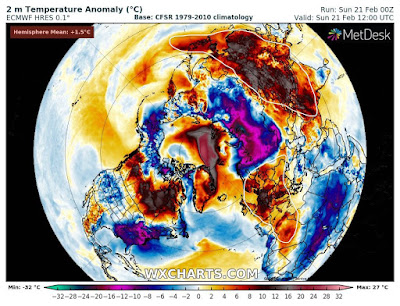 |
| The week ending February 20 was a very rare week in which global temperatures actually ran a bit below normal. Intense cold waves in the United States and Siberia drove the average down. |
Global temperatures for the week ending February 20 actually averaged out a wee bit cooler than average. It's likely that it was the first "cool" week on Earth since at least 2014.
Once upon a time, you'd expect a mix of cool weeks and months and warm weeks and months on a global average. But now the world is running a fever under climate change.
January was the 433rd consecutive month in which global temperatures were warmer than average. That's 36 years!
February will not break this long global warm streak as three of the four weeks will average warmer than normal for the world as a whole. Still, this looks to be the coolest global February in years. We'll have the official data on February around mid-March, so watch this space. I'll update it then.
The last five years or so have globally been the warmest on record, too. It appears quite possible that 2021 will break that streak as well, as January was "only" the seventh warmest on record. Most months in recent years have been in the top three warmest.
To be clear, this one cool global week in February is NOT a sign that climate change is ending or easing. That the year will turn out "cooler" than recent years is no surprise to scientists. Climate change is etched on top of natural variability. Some years will be cooler than others, but the overall trend is up.
Right now, there's a rather strong La Nina going on, which is a cooling of the Pacific Ocean off the coast of South America.
This pattern tends to have a cooling effect on the world as a whole. The opposite pattern, El Nino, features warm water in the eastern Pacific and a general warming trend in the world. '
It's inevitable we'll switch to El Nino eventually, as it always goes back and forth between the two patterns. We just don't know when that switch might happen.
The United States cold wave dominated the news in the past week, but there were still extraordinary hot spots on Earth this month.
While parts of the world were freezing, China, the Arctic, much of western Europe and a big chunk of Canada have been much warmer than normal in recent days. By Sunday, the core of the United States freeze zone - the southern Plains, have popped back up to somewhat warmer than average weather the past couple of days.
North Korea also had its warmest February day on record with a reading of 63 degrees in Pyongyang. South Korea, also broke a national February high temperature record with 77 degrees in Pahong.
Analysis for just today suggest the world is 0.8 degrees warmer than average. The only real cold spot today was western Russia.
Clearly, the global heat has not been shut off. At least for most of us.


No comments:
Post a Comment